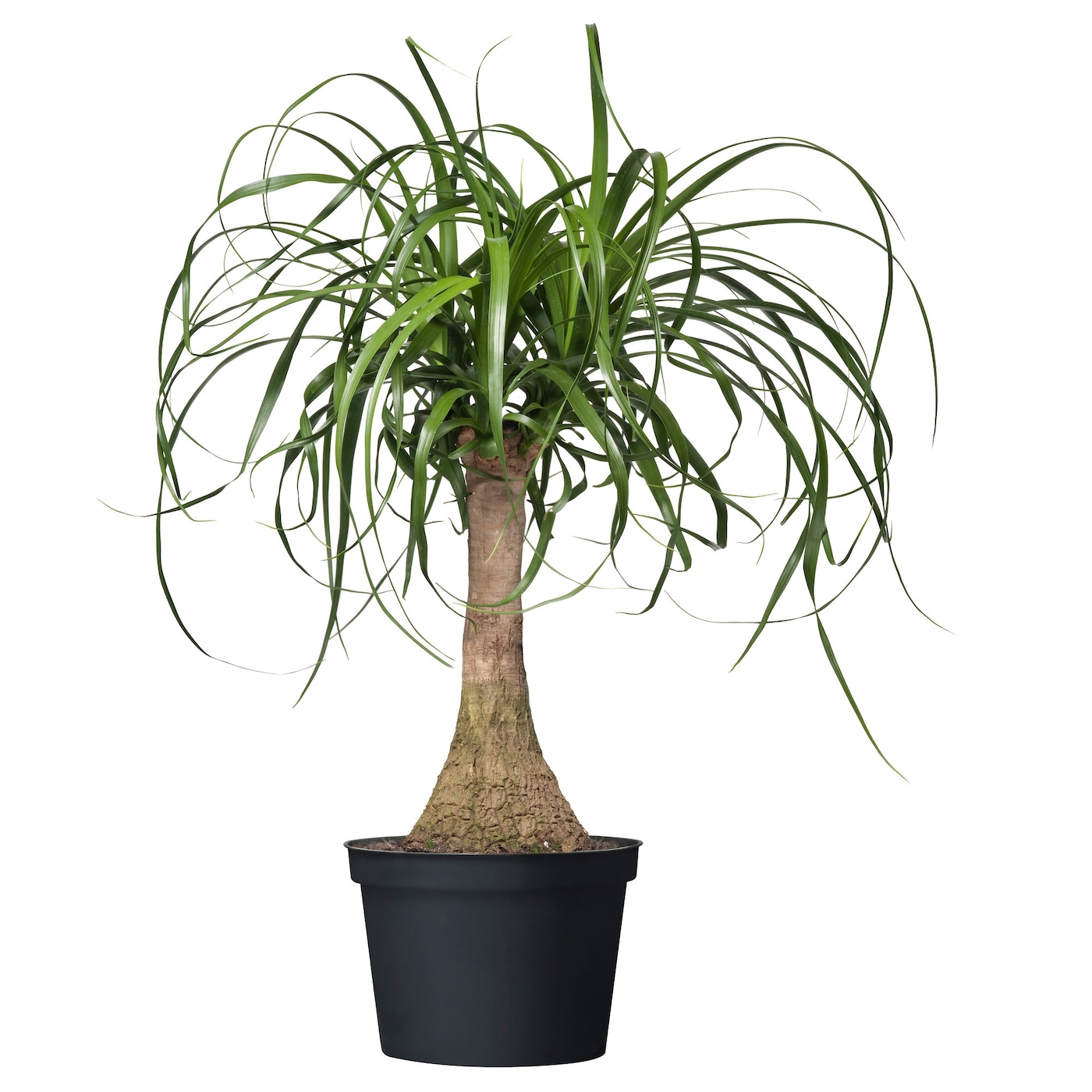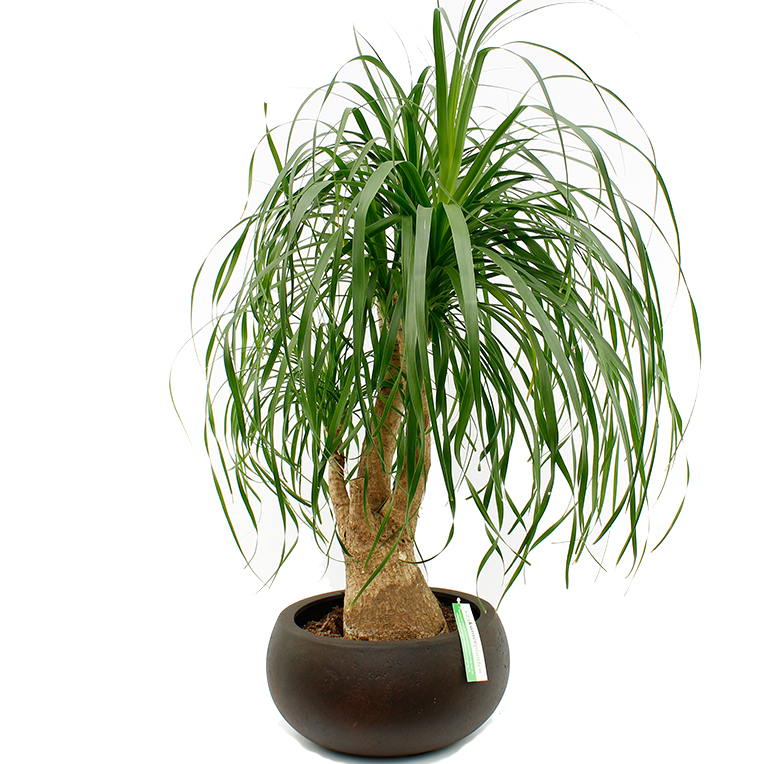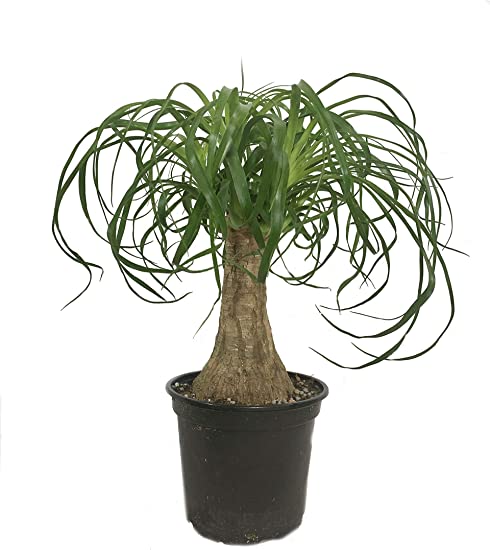
The Elephant’s Foot, officially known as Beaucarnea Recurvata, is a tropical looking houseplant. It has the funny nickname “Elephant’s Foot” because of its stem. The way the plant is in the ground, it looks like there is no plant, but an elephant’s leg in the planter. Now that’s a unique plant! Like the elephant, this plant is reminiscent of faraway places. And rightly so, because this plant originally comes from Central America. Think of the region of Mexico: a nice warm climate and the quiet, simple atmosphere that goes with it. This plant loves it. It requires relatively little maintenance.
Table of Contents
Naming and nicknames
It is quite possible that you do not yet know the botanical name of this plant: Beaucarnea Recurvata (sometimes also called Nolina Recurvata). Much better known is this plant by its nickname: Elephant Paw Plant or Elephant Paw for short.
The discoverer of Beaucarnea
Because the Beaucarnea is found in such warm areas, you would think that someone there would have already cultivated the plant species. But they didn’t. The plants were named after the Belgian Jean-Baptiste Beaucarne. He was a notary public and a plant collector. He managed to be the first to bring the plants back from the faraway places and grow them in Europe. You can still find a descendant of this first plant in the family home of Jean-Baptiste in the town of Ename, in East Flanders.
The family of the Elephant Foot
If you want to get these plants in your home and grow them to a healthy level, here are some scientific facts. The plant belongs to the tribe Embryophyta: the land plants, the class spermatopsida: the seed plants. The clade of the plant is angiosperms and monocotyledons. It belongs to the family of Asparagaceae and the subfamily Nolinoideae. This plant family also includes the Yucca (Palm lily) and the easy houseplant Dracaena. So, learned something again today. Now you can start greening your home like a real plant expert with this tropical plant. Read on quickly for the care of the Elephant’s Foot.
Care of the Elephant Foot
The care of Beaucarnea: watering
If you want to give Beaucarne credit, you obviously need to know how to care for its plants. The most important thing you need to know is that the plant is used to heat. When you see these plants, it’s not surprising. From the large pliabilis that looks more like a tree, to the simpler houseplant nolina, you don’t need much imagination to mistake this plant for a palm tree
It is completely set up to go without water for a while. If water is available, it can store a supply of it in its trunk. Water it once every few days and it will be satisfied. In the dry summer you can give a little more water. But beware: the Elephant’s Foot can also drown. So it is better not to water once than once too much.
If you have watered the plant too much for too long, the leaves will turn yellow and fall off. You can still try to save the plant. Take it out of the pot and carefully remove all the wet soil from the root ball. Then place it back in the flowerpot with fresh (dry) soil. Then you have to wait and see whether saving the plant has helped or not.

You might have guessed it, but the Elephant’s Foot is used to a climate with lots of light. The more light it gets, the easier it will grow. If it gets a little less sunlight, it won’t die right away. It will, however, slow down its growth. So try to give it as much light as possible. A place in the shade will not do the plant any good. Like any plant, it needs light and will not thrive in the dark.
Be careful with the distance between the window and the plant. If your window faces south, then you should maintain a distance of about two or three feet between the window and the plant. Otherwise, it can just stand right next to it. Although you might not expect it, this plant is not used to being right in the sun. It won’t kill it, but it will take some time to get used to it.
Feeding the Elephant Foot
The Beaucarnea is a very easy plant to take care of: it does not need watering every day and as far as feeding is concerned, you do not have to worry about it much at all. That is because plant food does more harm than good. It is relatively easy to overfeed it. If you do, you burn its roots. So do it very carefully. It is advisable to give half the usual amount of plant food to keep your plant fit. You can use universal plant food for this, which is no problem.
Pruning the Beaucarnea
If you’ve ever seen or had a Beaucarnea in your home, as someone with green fingers you probably intuitively know what to do with this plant. It gets dried out brown or brownish yellow tips at the end of the leaves at some point. These sometimes fall off on their own. If that does not happen, you can use a pair of scissors to trim the plant a little. Sometimes pulling very gently is enough. Then you can just leave it alone
If you really want to be rigorous you can saw off the top of the stem once every three years. Then within a few months you will have fresh, new foliage. This is not necessary, but can be a fun project. An Elephant’s Foot is strong and will just grow back.
Earth and the pot
The Elephant’s Foot needs very little, in terms of water and nutrition. You also need to be a little careful when it comes to potting soil. When potting a plant, you may immediately think of soil or potting mix, but that does not do the plant much good. It is best to give it a cactus mix. This way you reduce the chance of an excess of water or nutrition and that the plant burns or drowns. Through the cactus mix everything can flow away much easier than in normal potting soil. Make sure there are always holes in the bottom of the pot.
Repotting the Beaucarnea
If you want to remove the Beaucarnea from its growing pot, you should make sure that the replacement pot has holes in the bottom for proper water drainage. But because of its growth, repotting will not be necessary anytime soon. In an average living room the trunk does not have a high growth rate. The growth is only in the leaves, which at most will take up some more space in width. If the plant does end up growing out of joint, make sure that its new pot is 20% larger, so that it can continue to grow calmly and healthily without being squeezed. Repot only in the spring.
The ideal temperature for the Elephant Foot
The Beaucarnea is an ideal living room plant because the average temperatures of a living room are very suitable for the plant. It should be at least twelve degrees during the day and at least three at night. At those temperatures, the average person has long turned up the heating a bit, so that should not be a problem.
The Beaucarnea flowers
It’s always nice when a plant can also bloom. Don’t count on that with the Beaucarnea, however. The plant can flower, but does not do so with the temperatures and climate of the average living room. If you do see some flowers appear, they are not the ones you would show off: they are small and inconspicuous. It is better to remove them, because the plant will not be able to grow as fast. It will spend more energy doing so and will also lose some of its shine in the leaves.
Species
If you search for the Beaucarnea, you often come across the same plant in the offerings of online garden centers. But in fact there are several species of this plant. It is a whole family in itself. You often read about the Beaucarnea Nolina, but there are around twenty different subspecies. The best known species grows originally in Mexico, but you can also find them in Belize, Guatemala, Texas and California.

Can the Beaucarnea be placed outside?
It can, but only during the summer months. Make sure you do not place the plant outside in full sun or in a place with a lot of wind. In the autumn (and certainly in the winter) it has to go back inside. This also applies to many other popular houseplants such as the Banana plant and the Strelitzia.
Is this plant poisonous?
Because of its size, it can be added to the interior as a full-fledged piece of furniture, and because its leaves are not poisonous – not to humans, but not to animals either – it can be placed anywhere in the house without further concern. Cats in particular are often attracted to the spritely leaves. So this is not a problem. The foliage is somewhat reminiscent of that of the Chlorophytum, cats like that too.
A sick Elephant’s foot
Well-known diseases of the Beaucarnea are mainly caused by the amount of nutrition or water the plant receives. Root rot is one such example. This occurs when the plant has to take in too much water at once
The plant is not susceptible to real diseases. Another advantage is that lice, mites or other pests are also not pronounced fond of this plant. Very occasionally it can happen that you have an unwanted guest. In that case it is best to fight the critters immediately to prevent worse. In that case you can use either a chemical or biological pesticide.
Can you take cuttings from this plant?
No, you can’t take cuttings from this plant. Propagation is only possible by sowing the seeds. Looking for an indoor plant that you can take cuttings from? Then the Philodendron or the Tradescantia are a good option.
Is the Beaucarnea air purifying?
A little. There are many houseplants that do this better such as the Sanseveria and the Monstera.
What to watch out for when buying a Beaucarnea
If you want to have a Beaucarnea in your home, you can go to any garden center. If you want to know if the plant fits your interior, here are some facts to take into account. The shortest plants are about fifty centimeters high, but they are also available with a ‘starting length’ of no less than one hundred and eighty centimeters. This means that the plant is already at least 10 years old when it leaves the nursery.
The diameter of the plants can vary from nineteen to about fifty-five centimeters. So you would do well to first consider where you want to put the plant and whether it will fit there. After all, it will reach an advanced age and become part of the atmosphere in your living room for a long time. The Beaucarnea can become decades old. If the plant does not have enough space, it will become a mess. Especially if the leaves are pressed together due to lack of space as they continue to grow.
